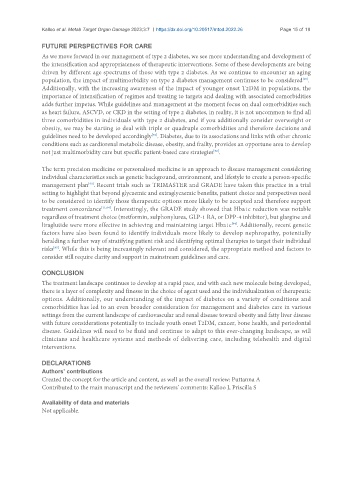Page 54 - Read Online
P. 54
Kalloo et al. Metab Target Organ Damage 2023;3:7 https://dx.doi.org/10.20517/mtod.2022.26 Page 15 of 19
FUTURE PERSPECTIVES FOR CARE
As we move forward in our management of type 2 diabetes, we see more understanding and development of
the intensification and appropriateness of therapeutic interventions. Some of these developments are being
driven by different age spectrums of those with type 2 diabetes. As we continue to encounter an aging
[90]
population, the impact of multimorbidity on type 2 diabetes management continues to be considered .
Additionally, with the increasing awareness of the impact of younger onset T2DM in populations, the
importance of intensification of regimes and treating to targets and dealing with associated comorbidities
adds further impetus. While guidelines and management at the moment focus on dual comorbidities such
as heart failure, ASCVD, or CKD in the setting of type 2 diabetes, in reality, it is not uncommon to find all
three comorbidities in individuals with type 2 diabetes, and if you additionally consider overweight or
obesity, we may be starting to deal with triple or quadruple comorbidities and therefore decisions and
[91]
guidelines need to be developed accordingly . Diabetes, due to its associations and links with other chronic
conditions such as cardiorenal metabolic disease, obesity, and frailty, provides an opportune area to develop
[92]
not just multimorbidity care but specific patient-based care strategies .
The term precision medicine or personalised medicine is an approach to disease management considering
individual characteristics such as genetic background, environment, and lifestyle to create a person-specific
[93]
management plan . Recent trials such as TRIMASTER and GRADE have taken this practice in a trial
setting to highlight that beyond glycaemic and extraglycaemic benefits, patient choice and perspectives need
to be considered to identify those therapeutic options more likely to be accepted and therefore support
treatment concordance [11,94] . Interestingly, the GRADE study showed that Hba1c reduction was notable
regardless of treatment choice (metformin, sulphonylurea, GLP-1 RA, or DPP-4 inhibitor), but glargine and
liraglutide were more effective in achieving and maintaining target Hba1c . Additionally, recent genetic
[94]
factors have also been found to identify individuals more likely to develop nephropathy, potentially
heralding a further way of stratifying patient risk and identifying optimal therapies to target their individual
risks . While this is being increasingly relevant and considered, the appropriate method and factors to
[95]
consider still require clarity and support in mainstream guidelines and care.
CONCLUSION
The treatment landscape continues to develop at a rapid pace, and with each new molecule being developed,
there is a layer of complexity and finesse in the choice of agent used and the individualization of therapeutic
options. Additionally, our understanding of the impact of diabetes on a variety of conditions and
comorbidities has led to an even broader consideration for management and diabetes care in various
settings from the current landscape of cardiovascular and renal disease toward obesity and fatty liver disease
with future considerations potentially to include youth onset T2DM, cancer, bone health, and periodontal
disease. Guidelines will need to be fluid and continue to adapt to this ever-changing landscape, as will
clinicians and healthcare systems and methods of delivering care, including telehealth and digital
interventions.
DECLARATIONS
Authors’ contributions
Created the concept for the article and content, as well as the overall review: Puttanna A
Contributed to the main manuscript and the reviewers’ comments: Kalloo J, Priscilla S
Availability of data and materials
Not applicable.

